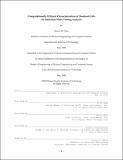Computationally efficient characterization of standard cells for statistical static timing analysis
Author(s)
Chou, Sharon H
DownloadFull printable version (983.8Kb)
Other Contributors
Massachusetts Institute of Technology. Dept. of Electrical Engineering and Computer Science.
Advisor
Alice Wang and Dennis Buss.
Terms of use
Metadata
Show full item recordAbstract
We propose a computationally efficient statistical static timing analysis (SSTA) technique that addresses intra-die variations at near-threshold to sub-threshold supply voltage, simulated on a scaled 32nm CMOS standard cell library. This technique would characterize the propagation delay and output slew of an individual cell for subsequent timing path analyses. Its efficiency stems from the fact that it only needs to find the delay or output slew in the vicinity of the ?- sigma operating point (where ? = 0 to 3) rather than the entire probability density function of the delay or output slew, as in conventional Monte-Carlo simulations. The algorithm is simulated on combinational logic gates that include inverters, NANDs, and NORs of different sizes. The delay and output slew estimates in most cases differ from the Monte-Carlo results by less than 5%. Higher supply voltage, larger transistor widths, and slower input slews tend to improve delay and output slew estimates. Transistor stacking is found to be the only major source of under-prediction by the SSTA technique. Overall, the cell characterization approach has a substantial computational advantage compared to SPICE-based Monte-Carlo analysis.
Description
Thesis (M. Eng.)--Massachusetts Institute of Technology, Dept. of Electrical Engineering and Computer Science, 2009. This electronic version was submitted by the student author. The certified thesis is available in the Institute Archives and Special Collections. Includes bibliographical references (p. 44-45).
Date issued
2009Department
Massachusetts Institute of Technology. Department of Electrical Engineering and Computer SciencePublisher
Massachusetts Institute of Technology
Keywords
Electrical Engineering and Computer Science.